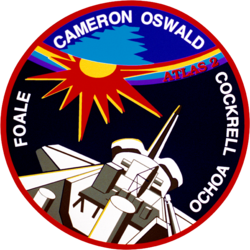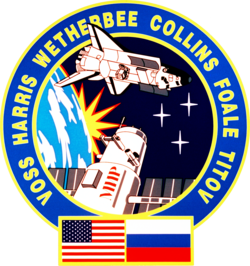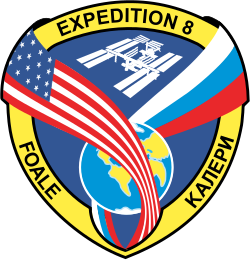Michael Foale
| Michael Foale | |
|---|---|
 | |
| Land | USA |
| Organisation | NASA |
| ausgewählt | 5. Juni 1987 (12. NASA-Gruppe) |
| Einsätze | 6 Raumflüge |
| Start des ersten Raumflugs | 24. März 1992 |
| Landung des letzten Raumflugs | 30. April 2004 |
| Zeit im Weltraum | 373d 18h 18min |
| EVA-Einsätze | 4 |
| EVA-Gesamtdauer | 22h 44min |
| ausgeschieden | August 2013 |
| Raumflüge | |
Colin Michael Foale CBE (* 6. Januar 1957 in Louth, Lincolnshire, Großbritannien) ist ein ehemaliger US-amerikanischer Astronaut, der ebenfalls britischer Staatsbürger ist. Bis 2008 war er der US-Amerikaner mit dem längsten Gesamtaufenthalt im All: 373 Tage, 18 Stunden und 18 Minuten, dann wurde dieser Rekord von Peggy Whitson gebrochen. Außerdem war Foale der erste Brite, der eine Außenbordtätigkeit absolvierte.
Foale erhielt an der Kings School in Canterbury eine humanistische Ausbildung. Sein Abschlusszeugnis erhielt er 1975. Danach besuchte er die Universität Cambridge. An deren Queens’ College studierte er zunächst Physik und erwarb 1978 einen Bachelor. Vier Jahre später promovierte er im Fach Astrophysik. Als begeisterter Sporttaucher nahm er während seiner Studienzeit an mehreren wissenschaftlichen Tauchprojekten teil, die er teilweise selbst organisierte.
Anfang der 1980er Jahre siedelte Foale in die USA über und nahm für kurze Zeit eine Tätigkeit bei McDonnell Douglas im texanischen Houston an, bevor er im Sommer 1983 im Johnson Space Center anfing. Er war im Flugkontrollzentrum bis zum Frühjahr 1986 für den Nutzlastbetrieb bei Shuttle-Missionen zuständig.
2003 wurde Foale Kommandant der ISS-Expedition 8 (zusammen mit dem Kosmonauten Alexander Kaleri). Sein sechsmonatiger Aufenthalt im All endete am 29. April 2004.
Mit diesem Flug zog er mit den Astronauten John Young, Story Musgrave, Jerry Ross, Franklin Chang-Diaz, Curtis Brown, Jim Wetherbee, gleich, die vor ihm sechs Raumflüge absolvieren durften.
Er wurde im Dezember 2004 zum Commander of the British Empire ernannt.
Foale verließ die NASA im August 2013, um ein elektrisches Flugzeug zu konstruieren, das die Kosten um 90 % senken soll. Außerdem ist er Berater der Inspiration-Mars-Stiftung.
Weblinks
- Chris Bergin und Chris Gebhardt: The amazing space adventures of Michael Foale (englisch)
- Kurzbiografie von Michael Foale bei spacefacts.de
- NASA-Biografie von Michael Foale (englisch; PDF)
| Personendaten | |
|---|---|
| NAME | Foale, Michael |
| ALTERNATIVNAMEN | Foale, Colin Michael (vollständiger Name) |
| KURZBESCHREIBUNG | US-amerikanischer Astronaut |
| GEBURTSDATUM | 6. Januar 1957 |
| GEBURTSORT | Louth, Lincolnshire, England |
Auf dieser Seite verwendete Medien
STS-45 Mission Insignia
Soyuz TMA-3 crew patch, designed by Luc van den Abeelen.
STS-56 Mission Insignia
STS-63 Mission Insignia
The STS-84 emblem depicts the Space Shuttle Atlantis launching into Earth orbit to join the Russian Space Station Mir as part of Phase One (Shuttle-Mir) of the International Space Station program. The names of the eight astronauts who flew onboard Atlantis, including the two who changed their positions onboard Mir for a long duration flight, are shown along the border of the patch. The STS-84/Mir-23 team will transfer 7,000 pounds of experiments, Station hardware, food and clothing to and from Mir during the five-day period of docking. The Phase One program is represented by the rising Sun and by the Greek letter Phi followed by one star. This sixth Shuttle-Mir docking mission is symbolized by the six stars surrounding the word Mir in Cyrillic characters. Combined, the seven stars symbolize the current configuration of Mir, composed of six modules launched by the Russians and one module brought up by Atlantis on a previous docking flight.
This emblem represents the eighth long-duration expedition to the International Space Station. The banner encircling the Earth, as a stylized figure 8, combines the flags of the partner nations represented by the crew. The International Space Station is portrayed above the Earth in its assembly complete configuration. The names of the two crewmembers, Michael Foale and Alexander Kaleri, are depicted in the border.
Designed by the crewmembers, the STS-103 emblem depicts the Space Shuttle Discovery approaching the Hubble Space Telescope (HST) prior to its capture and berthing. The purpose of the mission is to remove and replace some of the Telescope's older and out-of-date systems with newer, more reliable and more capable ones, and to make repairs to HST's exterior thermal insulation that has been damaged by more than nine years of exposure to the space environment. The horizontal and vertical lines centered on the Telescope symbolize the ability to reach and maintain a desired attitude in space, essential to the instrument's scientific operation. The preservation of this ability is one of the primary objectives of the mission. After the flight, the Telescope will resume its successful exploration of deep space and will continue to be used to study solar system objects, stars in the making, late phases of stellar evolution, galaxies and the early history of the universe. HST, as represented on this emblem was inspired by views from previous servicing missions, with its solar arrays illuminated by the Sun, providing a striking contrast with the blackness of space and the night side of Earth.
- The NASA insignia design for Shuttle flights is reserved for use by the astronauts and for other official use as the NASA Administrator may authorize. Public availability has been approved only in the form of illustrations by the various news media. When and if there is any change in this policy, which is not anticipated, it will be publicly announced.







